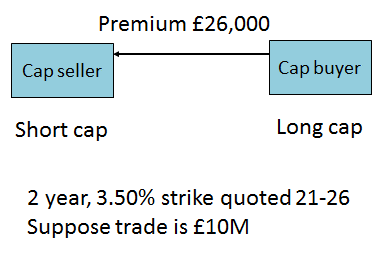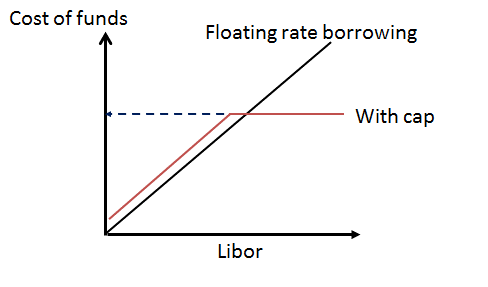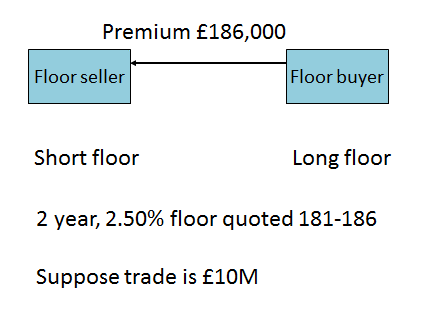
Barbican Consulting Limited
Interest Rate Options

Interest Rate Caps
Interest rate caps are a string of options on forward starting Libor. The individual option is called a “caplet” with the combined sum of each caplet’s value giving the cap price or premium.
Forward interest rates are calculated from the par yield curve. To help understand them a simple example helps.
If you borrow money for six months and deposit it for three months there is a rate of interest that you need to receive on your deposit between month three and month six in order to give you sufficient cash to repay your initial borrowing with interest. This is the breakeven or forward rate:

A simple calculation gives you the answer:

This shows the forward interest rate between month three and month six is 3.98%.
This rate and the subsequent forward rates constitute the underlying risk that is being traded in the cap and floor market.
A cap has a principal amount, strike and maturity date. The buyer of the cap receives a payment from the seller when, on specific reference dates (normally every 3 months), Libor exceeds the agreed strike. Here is an example:

The two year 3.50% strike cap has a price of 21/26 basis points. A buyer (crossing the bid-offer spread) would pay the seller 0.26% flat of the principal amount up front:

Every three months (on specific dates) for the next two years reference would be made to the three month Libor “fixing” rate.
If on any one of the reference dates Libor does not exceed the strike of 3.50% no payments are made.
If on any one of the reference dates Libor exceeds the strike of 3.50% a payment would be made by the seller to the buyer. This would equal the principal x (Libor – strike) x days / 360 or 365:

The risk to the seller is therefore one of rising interest rates. In theory it is an unlimited risk. For the buyer the risk is limited to that of the premium payment.
Caps are frequently associated with interest rate hedging and in particular a variable rate borrower protecting against the risk of higher interest rates.
This diagram compares the cost of borrowing for a company using a floating rate loan or a floating rate loan together with the purchase of a cap:

Interest Rate Floors
Floors are also options on forward starting Libor. Whereas a cap is a call option a floor is a put option on the forward rate. The seller receives a premium from the buyer. In return if Libor is beneath the strike on specific future dates, a payment is made by the seller to the buyer. Here are some floor prices:

The two year 2.50% strike floor has a price of 181/186 basis points. A buyer pays the seller an upfront amount equal to the principal multiplied by 186 basis points (again assuming crossing the dealing spread):

If on any one of the reference dates Libor is higher than the strike of 2.50% no payments are made.
If on any one of the reference dates Libor is beneath the strike of 2.50% a payment would be made by the seller to the buyer. This would equal the principal x (strike- Libor) x days / 360 or 365:

The risk to the seller is therefore one of falling interest rates. In theory it is an unlimited risk. For the buyer the risk is limited to that of the premium payment. Floors are frequently associated with hedging investment returns.
What is a Collar?
A long collar is a term that is applied to a long cap, short floor position. In a rising interest rate environment the long cap position gains (pays out) whereas if interest rates fall there is a loss (payment is made) on the short floor position.
Why enter a collar?
Because a floor is being sold a premium is received. This is used to buy the cap. In other words the short option pays for the long option and there is no net payment of cash. A borrower paying a Libor linked loan rate would then have both a maximum and minimum borrowing cost:

Swaptions
As the name suggests swaptions are options on swaps. These swaps start in the future so dealers talk about a “two year into a five year” meaning the option expires in two years and with the underlying swap being a five year swap thereafter. There are two types of swaption:
1. A payer’s swaption: this permits the buyer to enter into a swap and pay fixed interest receiving floating interest on the exercise date. The amount, option maturity, strike (swap fixed rate) and maturity of the underlying swap are all subject to negotiation between the buyer and seller. Here is an example:

The deal is agreed and the buyer pays the seller an upfront premium. When the exercise date is reached the buyer must decide on whether to exercise. If the swap is out-of-the-money (OTM) the option expires worthless. If it is in-the-money the option is exercised by the buyer. The buyer then enters a three year swap to pay fixed interest at the strike rate with the seller:

This option would be exercised if the three year swap rate on expiry was higher than 3%.
2. A receiver’s swaption: The buyer of the option has the right to exercise the option to enter a forward starting swap in order to receive fixed interest and pay floating interest. The amount, option maturity, strike (swap fixed rate) and maturity of the underlying swap are all subject to negotiation between the buyer and seller. Here is an example:

The buyer pays the seller the premium. On the exercise date the buyer has the right to enter into a swap to receive fixed interest:

The buyer would exercise this option it was in-the-money. That is when, in this case, the market swap rate is below 3.00%. Otherwise the option expires worthless.
Contract for difference or a real swap?
Depending on what is agreed between the two parties exercise of the swaption can lead to a cash payment representing the mark-to-market value of the underlying swap or a real “physical” deal.
Dealers prefer cash settlement. This is because they are not obliged to enter into a swap with the counterparty whose credit risk may have deteriorated in the intervening period. If there is cash settlement the option buyer can still enter into a swap albeit at the prevailing market rate with a different counterparty.
Swaption Use
Loans that give the borrower the right to change from a floating interest rate to a fixed rate or vice versa effectively give the borrower a long option position. To hedge this risk a bank would need to buy the appropriate swaption. Even if the bank does not fully hedge it should be aware of the value of the option in order that the loan is correctly priced.
Optionality as a Risk
Banks frequently experience option type risks within their balance sheets. For example loans that have a minimum interest rate benefit the bank as interest rates fall (the bank is long a floor) however as rates rise this benefit is lost and can mean that net interest income falls as interest rate increase.
Mortgage portfolios can also be difficult to hedge. First there is the pipeline risk. Just when does a bank recognise the loan and resultant risk? Is it when the loan offer is made or is it when the loan is actually drawn down? If swaps are used to hedge this is a type of swaption risk that is dependent on the number of mortgages that go on to completion. Hedging is tricky.
Furthermore fixed rate mortgages are often hedged by the bank paying fixed interest on a swap. If the amortisation profile of the mortgage portfolio changes the initial hedging strategy will need rebalancing.
This too is a type of swaption risk that in this case is also dependent on customer behaviour and pre-payment/extension risk. Hedging these risks is far from simple. Notwithstanding a bank should have a good idea of the value of the risk at its inception.
First Published by Barbican Consulting Limited 2014